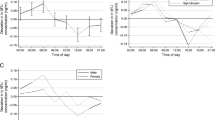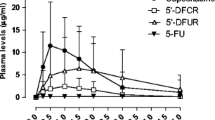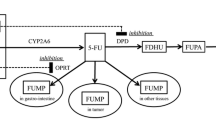Summary
Serum concentrations of 5-fluorouracil (5-FU) given by continuous infusion to 19 patients with advanced colonic cancer were measured by an HPLC method, and steady-state concentration (SSc), area under the curve (AUC72) and total body clearance (Cl) were calculated as pharmacokinetic parameters. The serum level of 5-FU rapidly increased, reaching a plateau within 2 h after the start of administration. There were positive correlations between the dose and both SSc (r = 0.578,P <0.01) and AUC72 (r = 0.558,P <0.05). When the patients were divided into toxic and non-toxic groups according to the degree of toxicity, the values for SSc and AUC72 in the toxic group were significantly higher than those in non-toxic patients. The Cl value in the toxic group was also significantly different from that in the non-toxic group when data were calculated on a log scale. Furthermore, no differences in these parameters between effective and non-effective groups were detected when the patients were divided into two groups according to anti-neoplastic responses. These results indicate that increased serum concentration does not always provide therapeutic benefits to patients receiving continuous infusions of 5-FU.
Similar content being viewed by others
References
Cantrell JE, Hart RD, Taylor RF, Harvey JH (1987) Pilot trial of prolonged continuous-infusion 5-fluorouracil and weekly cisplatin in advanced colorectal cancer. Cancer Treat Rep 71: 615
Curreri AR, Ansfield FJ, Mclever FA, Waisman HA, Heidelberger C (1958) Clinical studies with 5-fluorouracil. Cancer Res 18: 478
Hansen RM, Quebbeman E, Anderson T (1989) 5-Fluorouracil by protracted venous infusion. Oncology 46: 245
Hillcoat BL, McCulloch PB, Figueredo AT, Ehsan MH, Rosenfeld JM (1978) Clinical response and plasma levels of 5-fluorouracil in patients with colonic cancer treated by drug infusion. Br J Cancer 38: 719
Horton J, Olson KB, Sullivan J, Reilly C, Shnider B, for the Eastern Cooperative Oncology Group (1970) 5-Fluorouracil in cancer: an improved regimen. Ann Intern Med 73: 897
Iigo M, Araki E, Nakajima Y, Hoshi A, Clercq E (1988) Enhancing effect of bromovinyldeoxyuridine on antitumor activity of 5-fluorouracil against adenocarcinoma 755 in mice. Biochem Pharmacol 37: 1609
Karter N, Riordan JR, Ling V (1983) Cell surface P-glycoprotein associated with multidrug resistance in mammalian cell lines. Science 221: 1285
Lokich JJ, Ahlgren JD, Gullo JJ, Philips JA, Fryer JG (1989) A prospective randomized comparison of continuous infusion fluorouracil with a conventional bolus schedule in metastatic colorectal carcinoma: a Mid-Atlantic Oncology Program Study. J Clin Oncol 7: 425
Moertel CG (1978) Chemotherapy of gastrointestinal cancer. New Engl J Med 299: 1049
Ozawa S, Sugiyama Y, Mitsuhashi J, Inaba M (1989) Kinetic analysis of cell killing effect induced by cytosine arabinoside and cisplatin in relation to cell cycle phase specificity in human colon cancer and Chinese hamster cells. Cancer Res 49: 3823
Reichman B, Markman M, Hakes T, Kemeny N, Kelsen D, Hoskins W, Rubin S, Lewis JL (1988) Phase I trial of concurrent intraperitoneal and continuous intravenous infusion of fluorouracil in patients with refractory cancer. J Clin Oncol 6: 158
Shimoyama M (1975) Cytocidal action of anticancer agents: evaluation of the sensitivity of cultured animal and human cancer cells. In: Comparative leukemia research 1973. Leukemogenesis. University of Tokyo Press, Tokyo/Karger, Basel, p 711
Spicer DV, Ardalan B, Daniels JR, Silberman H, Johnson K (1988) Reevaluation of the maximum tolerated dose of continuous venous infusion of 5-fluorouracil with pharmacokinetics. Cancer Res 48: 459
Wallenstein S, Zucker CL, Fleiss JL (1980) Some statistical methods useful in circulation research. Circ Res 47: 1
World Health Organization (1979) Reporting of response. In: Handbook for reporting results of cancer treatment. WHO, Geneva, p 22
Author information
Authors and Affiliations
Additional information
This study was supported in part by a grant-in-aid (1-9) for cancer research from the Ministry of Health and Welfare
Rights and permissions
About this article
Cite this article
Yoshida, T., Araki, E., Iigo, M. et al. Clinical significance of monitoring serum levels of 5-fluorouracil by continuous infusion in patients with advanced colonic cancer. Cancer Chemother Pharmacol 26, 352–354 (1990). https://doi.org/10.1007/BF02897292
Received:
Accepted:
Issue Date:
DOI: https://doi.org/10.1007/BF02897292




